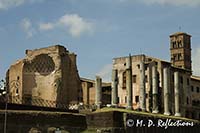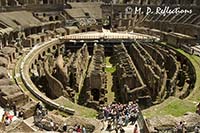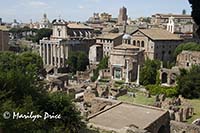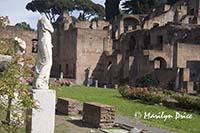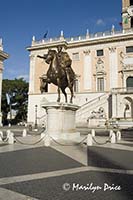May 9
May 10
May 11
May 12
May 13
May 14
May 15
May 16
May 17
May 18
May 19
May 20
May 21
May 22
May 23
May 24
May 25
May 26
May 27
May 28
May 29
May 30
After breakfast, we took off for a day in ancient Rome. Our main goal for the day was the Colosseum. On the way, we passed Trajan's Market and the Forum Augustus.
The photo on the left above shows poppies growing in what's left of Trajan's Market. The center photo above shows what remains of the Forum of Augustus. Forums were meeting places and general offices, usually for lawyers. The photo on the right above shows another view of the Forum of Augustus, including a stairway to no where!
The photo on the left above shows some of the intricate carvings remaining in a doorway of the Forum of Nerva. The photo on the right above shows the Temple of Venus and Rome as well as the bell tower for Santa Francesca Romana, which was built incorporating some of the walls from the Temple of Venus and Rome. The Temple of Venus and Rome was built by the Emperor Hadrian.
The photo on the left above is our first view of the Colosseum. I stepped into traffic to take it! At the Colosseum, we bought a tour, which allowed us to cut into the long line. Metal detectors here, too!! The Colosseum was fantastic. The large columns around the outside have several holes in them (see the photo above in the center). The columns were built without mortar - metal pins held the blocks of travertine together. Then, in the Middle Ages, when metal was scarce, people chipped into the blocks to pull out the metal pins. It's a wonder the thing is still standing! The photo on the right above shows Carl (in the hat) listening intently to the tour guide as she describes the interior of the Colosseum.
The maze of underground "backstage" was fascinating. Narrow passageways leading to cages or other areas which used pulleys to elevate the animals or gladiators to the arena floor. The stage or arena floor is long gone, so the backstage area is very visible - see the photo on the left below. The sort of stage at the far end of the arena is a modern addition and is used for occasional productions.
The place could seat many thousands of people. The lower your social class, the higher your seats were. And women, even noble women, had to sit in the highest rows with the slaves... Only the Vestal Virgins were allowed to sit lower down. They had front row seats, along with the senators. If you look closely at the photo on the left above, on the left side you can see a cross. This is a modern addition and is placed where the emperors watched the games. The supports for the lower tiers of seats are also visible in this photo. The photo on the right above shows the additional supports for the upper rows of seats.
The photo on the left above was taken from one of the upper levels of the Colosseum. It's the Arch of Constantine, built in 315 AD. From the Colosseum, we grabbed a quick bite to eat at My Bar, a gelatoria (ice cream place). We had ice cream and water Before leaving the Palantine Hill, we took some time to study the layout of the Roman Forum from above. The two photos above give a good overview of most of the Roman Forum. Starting on the left of the photo to the left above, you'll see the Temple of Antoninus and Faustina (the series of six columns). This temple was later converted to a church and, since they couldn't dislodge the columns, the columns were incorporated in the design, sort of a false front. The next temple (with the purplish columns) is the Temple of Romulus, build in the 4th century AD. It has a green door that is original to the original temple. It's now part of the curch of Santi Cosma e Damiano. In the photo on the right above, you'll see the church of Santa Francesca Romana with its bell tower. The back part of this church takes over the former Temple of Venus and Rome, which was built in 121 AD by the Emperor Hadrian. The arch is the Arch of Titus, and you can see the Colosseum in the background.
From the Palatine Hill, we explored the old Roman Forum on our own. It's amazing how much is still around. It was buried for several centuries and is now slowly reappearing. They have hauled about 20 feet of covering soil off of it.
The photo on the left above is another view of the Arch of Titus from the middle of the Roman Forum. The center photo above is the courtyard of the House of the Vestal Virgins, taken from the Palantine Hill. The photo on the right above is a closer view of the same courtyard, taken through a fence. The Vestal Virgins were the keepers of the eternal flame at the Temple of Vesta. There were about 30 of them at any given time, ten learning how to be a Vestal Virgin, ten actively protecting the flame, and ten teaching the newcomers. Once a woman had served her years as a Vestal, she was allowed to marry. The Vestal Virgins were the only women allowed in the lower tiers of the Colosseum.
The photo on the left above was taken from the Palantine Hill overlook and shows the Temple of Vesta. It has a partial wall still standing. You can also just make out the fact that this was a circular building and it backed the House of the Vestal Virgins. The center photo above was taken from the other side of the Temple of Vesta, showing what a section of this temple must have looked like. The photo on the right above shows the Temple of Saturn. And, yes, those are palm trees in the distance.
From there, we climbed the Capitiline Hill and saw the fantastic piazza at the top (Piazza del Campidoglio) designed by Michelangelo. Lovely. And nice views over the city. The photos to the left above are statues flanking the staircase of the Palazzo Senatorio, which currently houses the mayor's offices. It faces the Piazza del Campidoglio. They can also be seen in the background of the photo to the right. This is a statue of Marcus Aurelius, which stands in the center of this piazza.
The two photos above show Carl perusing the guide book while sitting at the edge of the Piazza del Campidoglio. He's easier to see in the one on the right.
The photo on the left above is the Cordonata, the great staircase Michelangelo designed for the Piazza del Campidoglio. The figures at the top of the stairs are Castor and Pollus with matching horses. The photo on the right above shows the traffic in Rome. I took the first picture, then turned around for the second. Then we walked back to the hotel. Tired, but satisfied.
After cleaning up, we walked over by the Pantheon (two blocks the other way from our hotel) and had a nice dinner in one of the side streets. They were restoring the building above us, so there was scaffolding in place around the building. This restaurant had put their tables straddling the scaffolding, which was black. I didn't see the lowest level and really cracked my shins on the lowest pipe!! Dinner was good anyway. After looking around the Pantheon, we returned to the hotel for bed...





